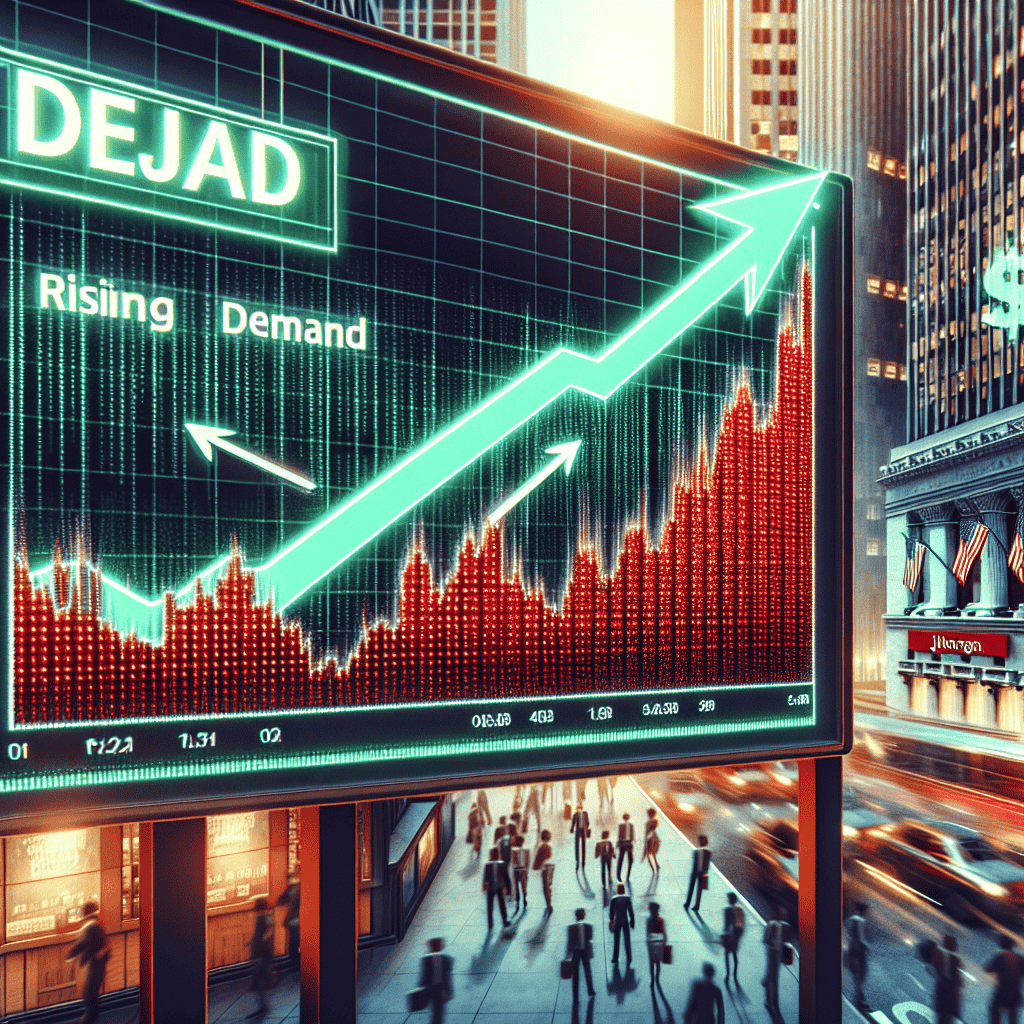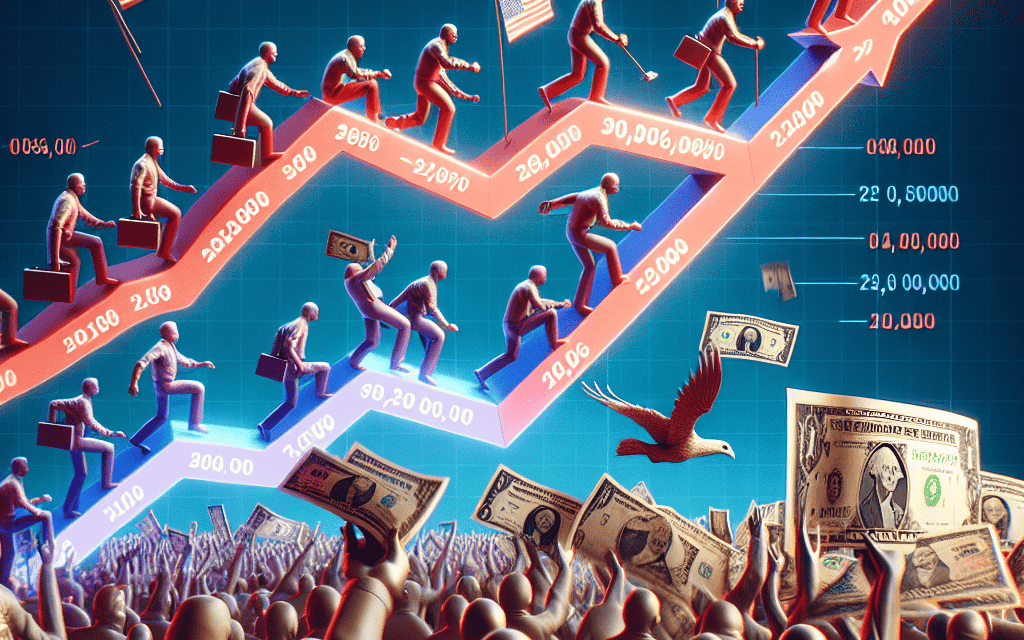“Rising Dollar Demand: JPMorgan Data Signals Economic Pulse Before US Election”
Introduction
In the lead-up to the US election, JPMorgan’s data reveals a significant surge in demand for the US dollar, underscoring its status as a global safe-haven currency amidst political uncertainty. This trend reflects investor sentiment and market dynamics as stakeholders seek stability in the face of potential electoral volatility. The rising dollar demand is indicative of broader economic implications, influencing global trade, investment strategies, and monetary policies. As the election approaches, the financial markets are closely monitoring these developments, with the dollar’s performance serving as a barometer for economic confidence and geopolitical stability.
Impact Of Rising Dollar Demand On Global Markets
The rising demand for the U.S. dollar, as evidenced by recent data from JPMorgan, is becoming increasingly significant as the United States approaches its upcoming election. This trend is not only a reflection of domestic economic conditions but also a crucial factor influencing global markets. As investors seek stability amidst political uncertainty, the dollar’s appeal as a safe-haven currency is amplified. Consequently, this surge in demand has far-reaching implications for international trade, investment flows, and economic stability across various regions.
To begin with, the strengthening of the U.S. dollar can have a profound impact on global trade dynamics. A stronger dollar makes U.S. exports more expensive and imports cheaper, potentially widening the trade deficit. This shift can adversely affect American manufacturers and exporters, who may find it challenging to compete in international markets. Conversely, countries that rely heavily on exporting goods to the United States might experience a decline in demand, which could lead to slower economic growth. Thus, the ripple effects of a robust dollar are felt across borders, influencing trade balances and economic policies worldwide.
Moreover, the rising dollar demand has significant implications for emerging markets. Many of these economies have substantial amounts of debt denominated in U.S. dollars. As the dollar appreciates, the cost of servicing this debt increases, putting additional financial strain on these countries. This situation can lead to tighter monetary conditions, reduced fiscal space, and, in some cases, financial instability. Emerging markets may be forced to raise interest rates to defend their currencies, which can stifle economic growth and exacerbate existing vulnerabilities. Therefore, the global financial landscape becomes more precarious as the dollar strengthens.
In addition to trade and debt considerations, the rising demand for the dollar also affects global investment flows. Investors, seeking to capitalize on the dollar’s strength, may redirect their capital towards U.S. assets, such as stocks and bonds. This shift can lead to capital outflows from other regions, particularly those perceived as riskier or less stable. As a result, countries experiencing capital flight may face depreciating currencies, increased borrowing costs, and heightened economic uncertainty. The interconnectedness of global financial markets means that changes in investor sentiment towards the dollar can have cascading effects on asset prices and economic conditions worldwide.
Furthermore, central banks around the world must navigate the challenges posed by a stronger dollar. For instance, countries with pegged or managed exchange rate regimes may need to intervene in foreign exchange markets to maintain their currency stability. Such interventions can deplete foreign reserves and limit the ability of central banks to respond to domestic economic challenges. Additionally, the divergence in monetary policy between the U.S. Federal Reserve and other central banks can exacerbate currency volatility, complicating efforts to achieve economic stability.
In conclusion, the rising demand for the U.S. dollar, as highlighted by JPMorgan’s data, underscores the complex interplay between domestic political events and global economic dynamics. As the U.S. election approaches, the dollar’s role as a safe-haven currency is likely to remain prominent, with significant implications for trade, investment, and monetary policy worldwide. Policymakers and market participants must remain vigilant, as the evolving landscape presents both challenges and opportunities in navigating the impacts of a strengthening dollar on global markets.
How JPMorgan Data Reflects Economic Trends
JPMorgan Chase & Co., one of the largest financial institutions in the world, has recently released data that underscores a significant rise in the demand for the U.S. dollar. This trend is particularly noteworthy as it unfolds in the lead-up to the upcoming U.S. election, a period often characterized by economic uncertainty and heightened market volatility. The data from JPMorgan serves as a valuable lens through which we can examine broader economic trends and investor behavior during such pivotal times.
To begin with, the increased demand for the U.S. dollar can be attributed to several interrelated factors. Historically, the dollar has been perceived as a safe-haven currency, especially during periods of geopolitical tension or economic instability. As the U.S. election approaches, investors are naturally inclined to seek stability, and the dollar, backed by the world’s largest economy, offers just that. This preference for the dollar is further amplified by the current global economic landscape, which is marked by fluctuating growth rates and varying levels of inflation across different regions.
Moreover, JPMorgan’s data highlights a shift in investment strategies among institutional investors. With the Federal Reserve maintaining a cautious stance on interest rates, there is a growing anticipation of potential policy changes post-election. Investors are keenly aware that any shifts in fiscal or monetary policy could have profound implications for currency markets. Consequently, many are opting to increase their dollar holdings as a preemptive measure against possible market disruptions. This strategic move is not only a reflection of the current economic sentiment but also an indication of the broader confidence in the U.S. economy’s resilience.
In addition to these factors, the data also reveals an interesting trend in global trade dynamics. As international trade continues to recover from the disruptions caused by the pandemic, the demand for the dollar has surged. This is largely because the dollar remains the dominant currency for global trade transactions. Companies engaged in cross-border trade are increasingly holding more dollars to hedge against currency fluctuations and to facilitate smoother transactions. This trend is further supported by the ongoing recovery in global supply chains, which has led to an uptick in trade volumes and, consequently, a higher demand for the dollar.
Furthermore, the data from JPMorgan provides insights into the behavior of retail investors. With the proliferation of digital trading platforms, retail investors now have greater access to currency markets. Many of these investors are capitalizing on the dollar’s strength by diversifying their portfolios to include dollar-denominated assets. This democratization of currency trading has contributed to the overall increase in dollar demand, as more individuals seek to leverage the currency’s stability and potential for appreciation.
In conclusion, the rising demand for the U.S. dollar, as evidenced by JPMorgan’s data, is a multifaceted phenomenon driven by a confluence of factors. From institutional investors adjusting their strategies in anticipation of policy changes to global trade dynamics and the growing participation of retail investors, the data reflects a complex interplay of economic trends. As the U.S. election draws nearer, it will be crucial to monitor these developments closely, as they will undoubtedly have far-reaching implications for both domestic and international markets. Through this lens, JPMorgan’s data not only highlights current economic trends but also offers a glimpse into the future trajectory of the global financial landscape.
US Election’s Influence On Currency Fluctuations
As the United States approaches another pivotal election, the financial markets are already exhibiting signs of anticipation, particularly in the currency sector. Recent data from JPMorgan Chase & Co. highlights a notable increase in demand for the U.S. dollar, a trend that is often observed in the lead-up to significant political events. This phenomenon can be attributed to a variety of factors, including investor sentiment, economic forecasts, and geopolitical considerations, all of which play a crucial role in shaping currency fluctuations.
To begin with, the U.S. dollar is traditionally viewed as a safe-haven currency, especially during periods of uncertainty. As the election draws near, investors tend to seek stability amidst potential volatility, leading to an increased demand for the dollar. This behavior is not uncommon, as historical patterns suggest that the dollar often strengthens in the months preceding an election. The rationale behind this trend is rooted in the desire to mitigate risk, as the outcome of the election could have far-reaching implications for both domestic and international economic policies.
Moreover, the current economic landscape further amplifies the demand for the dollar. With inflationary pressures persisting and the Federal Reserve maintaining a vigilant stance on monetary policy, the dollar’s appeal is bolstered. Investors are keenly aware that the central bank’s actions, influenced by the election’s outcome, could impact interest rates and, consequently, currency valuations. Therefore, the anticipation of potential shifts in fiscal and monetary policies under a new administration adds another layer of complexity to the currency market dynamics.
In addition to domestic factors, global geopolitical tensions also contribute to the rising demand for the dollar. As the world’s reserve currency, the dollar often benefits from international uncertainties, such as trade disputes or regional conflicts. In the context of the upcoming U.S. election, foreign investors may perceive the dollar as a more stable investment compared to other currencies, which could be subject to greater fluctuations due to their respective political climates. This perception is further reinforced by the dollar’s liquidity and widespread acceptance in global trade, making it an attractive option for those seeking to hedge against potential risks.
Furthermore, the data from JPMorgan underscores the strategic maneuvers by institutional investors who are positioning themselves ahead of the election. These entities often engage in currency hedging strategies to protect their portfolios from adverse movements in exchange rates. The increased demand for the dollar, as evidenced by JPMorgan’s findings, suggests that these investors are proactively adjusting their positions in anticipation of possible market disruptions. This proactive approach not only reflects the cautious sentiment prevalent among market participants but also highlights the intricate interplay between political events and financial markets.
In conclusion, the rising demand for the U.S. dollar, as indicated by JPMorgan’s data, is a multifaceted phenomenon driven by a confluence of factors. As the U.S. election looms, investors are navigating a complex landscape characterized by economic uncertainties, geopolitical tensions, and potential policy shifts. The dollar’s status as a safe-haven currency, coupled with its global prominence, positions it as a focal point for those seeking stability amidst the unpredictability of the electoral process. As such, the interplay between the U.S. election and currency fluctuations remains a critical area of focus for market participants worldwide.
Strategies For Investors Amid Dollar Strength

As the United States approaches another pivotal election, the financial landscape is witnessing a notable shift, particularly in the demand for the U.S. dollar. Recent data from JPMorgan Chase & Co. underscores this trend, highlighting a significant uptick in dollar demand. This development is not only a reflection of the current economic climate but also a signal for investors to reassess their strategies in light of the dollar’s strengthening position.
The dollar’s rise can be attributed to several factors, including geopolitical uncertainties, fluctuating interest rates, and the relative stability of the U.S. economy compared to other global markets. As investors seek safe havens amid these uncertainties, the dollar often emerges as a preferred choice. This preference is further bolstered by the Federal Reserve’s monetary policies, which have a direct impact on the currency’s value. Consequently, the dollar’s appreciation presents both opportunities and challenges for investors, necessitating a strategic approach to portfolio management.
In light of the dollar’s strengthening, investors are advised to consider diversifying their portfolios to mitigate potential risks. Diversification can be achieved by allocating assets across various sectors and geographies, thereby reducing exposure to currency fluctuations. For instance, investing in multinational corporations with substantial overseas revenues can provide a hedge against a strong dollar, as these companies often benefit from currency translation gains. Additionally, exploring emerging markets may offer growth opportunities that are less correlated with the U.S. dollar’s movements.
Moreover, investors should pay close attention to interest rate trends, as these are intrinsically linked to currency valuations. A rising interest rate environment typically enhances the appeal of the dollar, attracting foreign capital and further driving up its value. Therefore, monitoring the Federal Reserve’s policy decisions and economic indicators such as inflation and employment rates is crucial for making informed investment choices. By staying attuned to these factors, investors can better anticipate market shifts and adjust their strategies accordingly.
Another consideration for investors is the impact of a strong dollar on commodity prices. Commodities, often priced in dollars, tend to become more expensive for foreign buyers when the dollar appreciates. This dynamic can lead to decreased demand and lower prices, affecting sectors such as energy and agriculture. Investors with exposure to these industries should be mindful of these potential headwinds and consider strategies such as hedging or reallocating assets to mitigate risks.
Furthermore, the upcoming U.S. election adds an additional layer of complexity to the investment landscape. Political outcomes can significantly influence economic policies, trade agreements, and regulatory environments, all of which have implications for the dollar’s trajectory. As such, investors should remain vigilant and adaptable, ready to respond to any shifts in the political and economic landscape that may arise post-election.
In conclusion, the rising demand for the U.S. dollar, as evidenced by JPMorgan’s data, presents a multifaceted challenge for investors. By adopting a diversified approach, staying informed about interest rate trends, and considering the broader economic and political context, investors can navigate the complexities of a strong dollar environment. As the U.S. election draws near, maintaining a flexible and informed investment strategy will be essential for capitalizing on opportunities and mitigating risks in this evolving financial landscape.
Analyzing The Correlation Between Dollar Demand And Political Events
As the United States approaches another pivotal election, the financial markets are once again under the microscope, with particular attention being paid to the demand for the US dollar. Recent data from JPMorgan Chase & Co. has highlighted a significant uptick in dollar demand, a trend that often correlates with political events, especially those as consequential as a presidential election. Understanding this correlation requires a closer examination of the factors driving investor behavior and the broader economic implications.
Historically, the US dollar has been perceived as a safe-haven currency, a status that becomes particularly pronounced during periods of political uncertainty. Investors, both domestic and international, tend to flock to the dollar in times of potential volatility, seeking stability amidst the unpredictability of political outcomes. This behavior is not merely speculative; it is rooted in the dollar’s longstanding reputation as a reliable store of value, backed by the economic might of the United States. Consequently, as the election draws near, the demand for the dollar has surged, as evidenced by JPMorgan’s recent data.
Moreover, the anticipation of policy changes that could arise from a new administration further fuels this demand. Investors are keenly aware that different political parties prioritize different economic policies, which can have profound effects on markets. For instance, a shift towards more protectionist trade policies or significant changes in fiscal policy could impact the dollar’s strength. As such, market participants often adjust their portfolios in advance, increasing their dollar holdings to hedge against potential risks.
In addition to these considerations, the global economic landscape also plays a crucial role in shaping dollar demand. The US dollar is not only a domestic currency but also the world’s primary reserve currency, used extensively in international trade and finance. Therefore, global economic conditions, such as fluctuations in commodity prices or geopolitical tensions, can amplify the demand for dollars. In the current climate, with ongoing uncertainties in various regions, the dollar’s appeal is further enhanced, as investors seek to mitigate risks associated with other currencies.
Furthermore, the Federal Reserve’s monetary policy decisions are another critical factor influencing dollar demand. As the central bank navigates the complexities of inflation and economic growth, its actions can have significant repercussions on the dollar’s value. For instance, expectations of interest rate hikes can lead to increased dollar demand, as higher rates typically attract foreign capital seeking better returns. In the lead-up to the election, the Fed’s policy stance is closely monitored, adding another layer of complexity to the dynamics of dollar demand.
In conclusion, the rising demand for the US dollar, as highlighted by JPMorgan’s data, underscores the intricate relationship between political events and financial markets. As the election approaches, investors are strategically positioning themselves to navigate the potential uncertainties and opportunities that may arise. This behavior reflects a broader understanding of the dollar’s role as a safe-haven asset and its sensitivity to both domestic and global economic factors. As such, analyzing these trends provides valuable insights into the interplay between politics and economics, offering a glimpse into how market participants anticipate and respond to the ever-evolving landscape.
Implications Of A Strong Dollar For Emerging Economies
The rising demand for the US dollar, as evidenced by recent data from JPMorgan, has significant implications for emerging economies, particularly as the United States approaches its election period. This trend, while reflective of global economic dynamics, poses both challenges and opportunities for these economies. As the dollar strengthens, emerging markets often experience increased pressure on their currencies, leading to a cascade of economic effects that can influence their growth trajectories.
To begin with, a strong dollar typically results in the depreciation of emerging market currencies. This depreciation can lead to higher import costs, as goods and services priced in dollars become more expensive. Consequently, inflationary pressures may mount, forcing central banks in these economies to consider tightening monetary policies. Such measures, while aimed at stabilizing the currency, can inadvertently slow down economic growth by increasing borrowing costs and reducing consumer spending.
Moreover, many emerging economies have significant amounts of debt denominated in US dollars. As the dollar appreciates, the burden of these debts increases, as more local currency is required to meet dollar-denominated obligations. This situation can strain national budgets and limit the ability of governments to invest in critical infrastructure and social programs. In some cases, countries may face the risk of default, which can further destabilize their economies and erode investor confidence.
In addition to these challenges, a strong dollar can also impact trade balances. Emerging economies that rely heavily on exports may find their goods becoming less competitive in the global market due to the relative strength of the dollar. This shift can lead to reduced export revenues, exacerbating trade deficits and putting additional pressure on national currencies. As a result, countries may need to explore alternative strategies to boost their export sectors or diversify their economies to mitigate these effects.
However, it is important to note that a strong dollar is not entirely detrimental to emerging economies. For instance, countries that import significant amounts of commodities priced in dollars, such as oil, may benefit from lower import costs if commodity prices decline. Additionally, a strong dollar can attract foreign investment into emerging markets, as investors seek higher returns in economies with growth potential. This influx of capital can provide much-needed funding for development projects and stimulate economic activity.
Furthermore, the current global economic environment, characterized by uncertainty and volatility, underscores the importance of sound economic policies in emerging markets. By maintaining prudent fiscal and monetary policies, these economies can enhance their resilience to external shocks and better navigate the challenges posed by a strong dollar. Strengthening institutional frameworks and promoting transparency can also help build investor confidence and attract long-term investments.
In conclusion, the rising demand for the US dollar, as highlighted by JPMorgan’s data, presents a complex set of implications for emerging economies. While the challenges are significant, they are not insurmountable. By adopting strategic policy measures and fostering economic diversification, emerging markets can mitigate the adverse effects of a strong dollar and capitalize on potential opportunities. As the US election approaches, the global economic landscape will continue to evolve, and emerging economies must remain vigilant and adaptable to thrive in this dynamic environment.
Future Projections For The Dollar Post-Election
As the United States approaches another pivotal election, the financial world is closely monitoring the implications for the dollar, particularly in light of recent data from JPMorgan that highlights a rising demand for the currency. This trend is not only a reflection of current economic conditions but also a harbinger of potential shifts in the global financial landscape post-election. Understanding the factors driving this demand and projecting future movements of the dollar requires a nuanced analysis of both domestic and international influences.
To begin with, the increased demand for the dollar can be attributed to several key factors. Domestically, the U.S. economy has shown signs of resilience, with steady growth rates and a robust labor market. These indicators have bolstered investor confidence, making the dollar an attractive asset. Furthermore, the Federal Reserve’s monetary policy, characterized by interest rate adjustments, plays a crucial role in influencing the dollar’s strength. As interest rates rise, the dollar typically becomes more appealing to investors seeking higher returns, thereby increasing demand.
Internationally, geopolitical uncertainties and economic challenges in other regions have also contributed to the dollar’s appeal. For instance, ongoing economic struggles in Europe and Asia have led investors to seek the relative safety of the U.S. currency. The dollar’s status as the world’s primary reserve currency further amplifies its attractiveness during times of global instability. Consequently, these factors collectively underscore the dollar’s current upward trajectory.
Looking ahead to the post-election period, several scenarios could unfold, each with distinct implications for the dollar. If the election results in a continuation of current economic policies, it is likely that the dollar will maintain its strength, supported by ongoing investor confidence and favorable economic indicators. However, a shift in political leadership could introduce new fiscal and monetary policies, potentially altering the dollar’s trajectory. For instance, changes in trade policies or government spending could impact economic growth and, by extension, the dollar’s value.
Moreover, the global economic environment will continue to play a significant role in shaping the dollar’s future. As countries navigate post-pandemic recovery, their economic policies and growth rates will influence currency markets. A stronger recovery in other major economies could reduce the relative attractiveness of the dollar, while persistent challenges abroad might sustain its demand. Additionally, the evolution of international trade agreements and geopolitical relations will be critical in determining the dollar’s position on the global stage.
In conclusion, the rising demand for the dollar, as evidenced by JPMorgan’s data, is a multifaceted phenomenon driven by both domestic and international factors. As the U.S. election approaches, the financial community remains vigilant, aware that the outcome could significantly impact the dollar’s future trajectory. While current trends suggest continued strength, the interplay of political, economic, and global dynamics will ultimately shape the dollar’s path in the post-election landscape. Investors and policymakers alike must remain attuned to these developments, prepared to adapt to the evolving financial environment.
Q&A
1. **What is the main topic of the JPMorgan data?**
The main topic is the rising demand for the US dollar ahead of the US election.
2. **What does the JPMorgan data indicate about the US dollar?**
The data indicates an increased demand for the US dollar.
3. **Why is the demand for the US dollar rising according to the data?**
The demand is rising due to investor uncertainty and risk aversion ahead of the US election.
4. **How might the US election impact the dollar demand?**
The election could lead to increased volatility and uncertainty, prompting investors to seek the dollar as a safe-haven asset.
5. **What are investors likely doing in response to the rising dollar demand?**
Investors are likely increasing their holdings in US dollars and dollar-denominated assets.
6. **What role does JPMorgan play in this context?**
JPMorgan provides data and analysis on currency trends, including the rising demand for the US dollar.
7. **What could be the potential consequences of a rising dollar demand?**
A rising dollar demand could lead to a stronger US dollar, impacting global trade and emerging markets.
Conclusion
The rising demand for the US dollar, as evidenced by JPMorgan data ahead of the US election, underscores the currency’s status as a global safe haven amid political uncertainty. Investors often flock to the dollar during periods of potential volatility, seeking stability and security. This trend reflects broader market sentiments and expectations surrounding the election’s impact on economic policies and global markets. The increased demand may also influence currency exchange rates and international trade dynamics, highlighting the interconnectedness of political events and financial markets.





